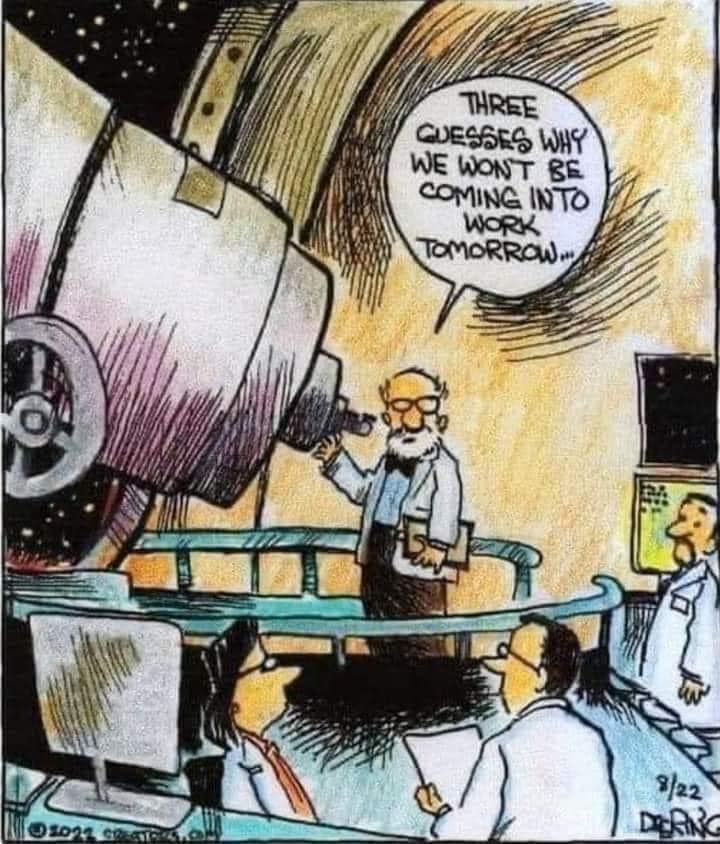Sweet Meteor
Posts
-
Say hello to my little friend. -
The opening ceremonies are on.I'm on it!

-
I'm just warmin' up here.NOAA forecasts severe solar storm;
NOAA’s Space Weather Prediction Center (SWPC) — a division of the National Weather Service — is monitoring the sun following a series of solar flares and coronal mass ejections (CMEs) that began on May 8. Space weather forecasters have issued a Severe (G4) Geomagnetic Storm Watch for the evening of Friday, May 10. Additional solar eruptions could cause geomagnetic storm conditions to persist through the weekend.
A large sunspot cluster has produced several moderate to strong solar flares since Wednesday at 5:00 am ET. At least five flares were associated with CMEs that appear to be Earth-directed. SWPC forecasters will monitor NOAA and NASA’s space assets for the onset of a geomagnetic storm.
CMEs are explosions of plasma and magnetic fields from the sun’s corona. They cause geomagnetic storms when they are directed at Earth. Geomagnetic storms can impact infrastructure in near-Earth orbit and on Earth’s surface, potentially disrupting communications, the electric power grid, navigation, radio and satellite operations. SWPC has notified the operators of these systems so they can take protective action. Geomagnetic storms can also trigger spectacular displays of aurora on Earth. A severe geomagnetic storm includes the potential for aurora to be seen as far south as Alabama and Northern California.
-
Navalny dead@Doctor-Phibes said in Navalny dead:
Anyway, getting back to American elections, how does everybody think the sun exploding would affect voter turnout?

-
I got competitionWell, it's California, so perhaps there's hope for civilization after all.
https://scitechdaily.com/california-supervolcano-caltechs-chilling-discovery-in-long-valley-caldera/
Caltech researchers used advanced imaging techniques to investigate increased seismic activity in California’s Long Valley Caldera, a dormant supervolcano.
Since the 1980s, researchers have observed significant periods of unrest in a region of California’s Eastern Sierra Nevada mountains characterized by swarms of earthquakes as well as the ground inflating and rising by almost half an inch per year during these periods. The activity is concerning because the area, called the Long Valley Caldera, sits atop a massive dormant supervolcano. Seven hundred and sixty thousand years ago, the Long Valley Caldera was formed in a violent eruption that sent 650 cubic kilometers of ash into the air—a volume that could cover the entire Los Angeles area in a layer of sediment 1 kilometer thick.
-
Hey SMOD, meet BennuI was busy with the kids, so I didn't see your story.
https://www.space.com/meteorite-impacts-moon-february-2023-video
-
Asteroid found 2 days after brush by Earth60K miles...
Missed it by that much.
Damn.
-
If you’re going to have to pick in 2024…You're a pipsqueak amateur.
Wanna see destruction?
Hold my corona.
-
I can be patientAstronomers Have Mapped The Paths of Hazardous Asteroids For The Next 1,000 Years
They are creating maps and catalogs of all potentially hazardous near-Earth objects, or NEOs. Obviously the larger rocks pose a bigger threat, but thankfully they are less numerous. And while our census of hazardous NEOs is not nearly complete, we do have reliable maps of nearly all of the potentially hazardous asteroids larger than a kilometer (0.6 mile) across.
This is useful, to say the least, because kilometer-scale asteroids have the potential to not only wipe out entire cities, but could cause significant ecological harm across the globe.
To estimate the risk that these large NEOs pose, a team of astronomers have predicted their orbits over the next thousand years. Their analysis suggests that none of these kilometer-scale NEOs pose a significant risk to us over the next century.
However, we have difficulty predicting the orbits of these NEOs past that. This is because in orbital dynamics small changes can lead to big effects over enormous timescales. A slight difference in the amount of heating that an asteroid receives from the Sun, or an unexpected tug from Jupiter, could send an asteroid on a trajectory that in a few thousand years ends up intersecting the Earth.
...
The astronomers identified one particular NEO, Asteroid 7482, as especially hazardous. This asteroid will spend a significant amount of time near the Earth for the next millennium. While that doesn't necessarily mean that it will strike our planet, it does mean that this rock poses the greatest chance of a collision within the next thousand years.
The researchers also highlighted another asteroid, Asteroid 143651, that has such a chaotic orbit that it's impossible to predict its exact position past a few decades. Thus while it might or might not pose a threat at all, based on our current understanding of its position and its velocity we cannot say for certain.
Altogether the astronomers identified 28 candidates that have a non-zero probability of a "deep encounter," which means they will pass within less than the distance to the Moon.
-
Mildly interesting@mark I pwned you hours ago.
-
Warming up -
Three Guesses
-
10 minutes until impact - watch nowYou can run, but you can't hide.
Wait...you guys can't even run, LOL.
-
Missed it by *that much.*Asteroid 4 times larger than Empire State Building to fly past Earth
Asteroids fly past the Earth on a regular basis, but Asteroid 7335 (1989 JA) is bigger than many of them, measuring 1.1 miles (5,900 feet) across. For comparison, it is four times larger than the Empire State Building and more than twice as large as the Burj Khalifa, located in Saudi Arabia, and the tallest building on the planet.
On May 27, the mammoth asteroid will make its closest encounter with our planet since its discovery, but rest assured, it will safely pass by with no threat of impact.
An artist's rendition of an asteroid flying past the Earth. Illustration by Sebastian Kaulitzki/Science Photo Library/Corbis
RELATED
NASA engineers investigate Voyager 1 spacecraft data mystery
Asteroid 7335 was discovered on May 1, 1989, and is one of 2,265 space rocks that NASA has labeled as a "potentially hazardous asteroid."
To be considered potentially hazardous, an asteroid has to measure at least 460 feet across and come within 4.6 million miles of Earth's orbit around the sun. This may sound close on a cosmic scale, but this distance is more than 19 times farther away than the moon is from the Earth.Near the end of the month, Asteroid 7335 will come within 2.5 million miles of the Earth, which is just over 10 times farther away than the moon. Not only is this the closest that it will come to the planet since its discovery, but this is the closest it will come through at least 2194.
Why is the press always so negative on me?
-
A Bad DaySay hello to my little friend.
-
Nihilist Meme of the Day
-
Just in time for HalloweenGet ready, baby.
I'm just warming up:
On Thursday (Oct. 28), the sun ejected a massive solar flare, the most powerful storm of our star’s current weather cycle.
According to the US Space Weather Prediction Center (SWPC), which tracks space weather events, the sun produced an X1-class solar flare, the most powerful type of flare. It peaked at 11:35 a.m. EDT (1535 GMT).
The flare caused a temporary but significant radio blackout across the sunlit side of Earth, centered on South America. The solar eruption was dubbed a “significant solar flare” by NASA officials, who added that it was captured on real-time video by the space agency’s Solar Dynamics Observatory.
According to SpaceWeather.com, a coronal mass ejection from the flare, a massive eruption of charged particles, could reach Earth by Saturday or Sunday (Oct. 30-31), just in time for Halloween. The eruption has the potential to intensify Earth’s northern lights and disrupt satellite-based communications.
“POW! The sun just served up a powerful flare,” NASA officials wrote on Twitter alongside a photo of the flare.
-
Missed it by *that* muchF'ing NASA was looking the WRONG WAY
The asteroid, named 2021 SG, has a diameter of around 42 to 94 m, with a diameter or around 68 m, which makes it around half the size of the great pyramids.
The asteroid tracker EarthSky has it listed for September 16, but NASA only detected it a day later.
Yep, we almost got hit by an asteroid that we didn’t even notice.
The asteroid got super close to us, according to EarthSky. It was around half the distance between the earth and the moon—that’s how close. It passed Greenland and Canada at just past midnight GST on the 17th, an extremely close call.
This has happened before, and will happen again. One came from the sun that was smaller on September 7 that was only around 3.5m, just 15 thousand km from the earth.
-
What would be your first sentence?Say hello to your little friend.
-
Say hello to my little friend